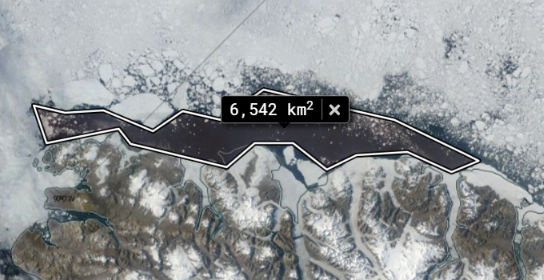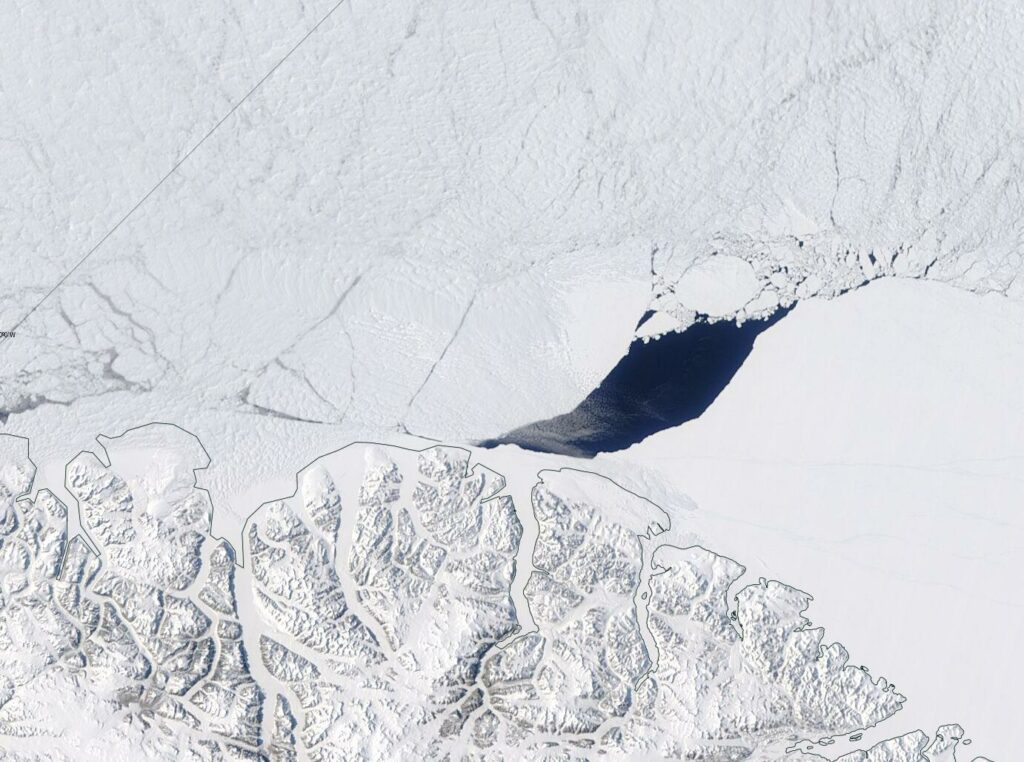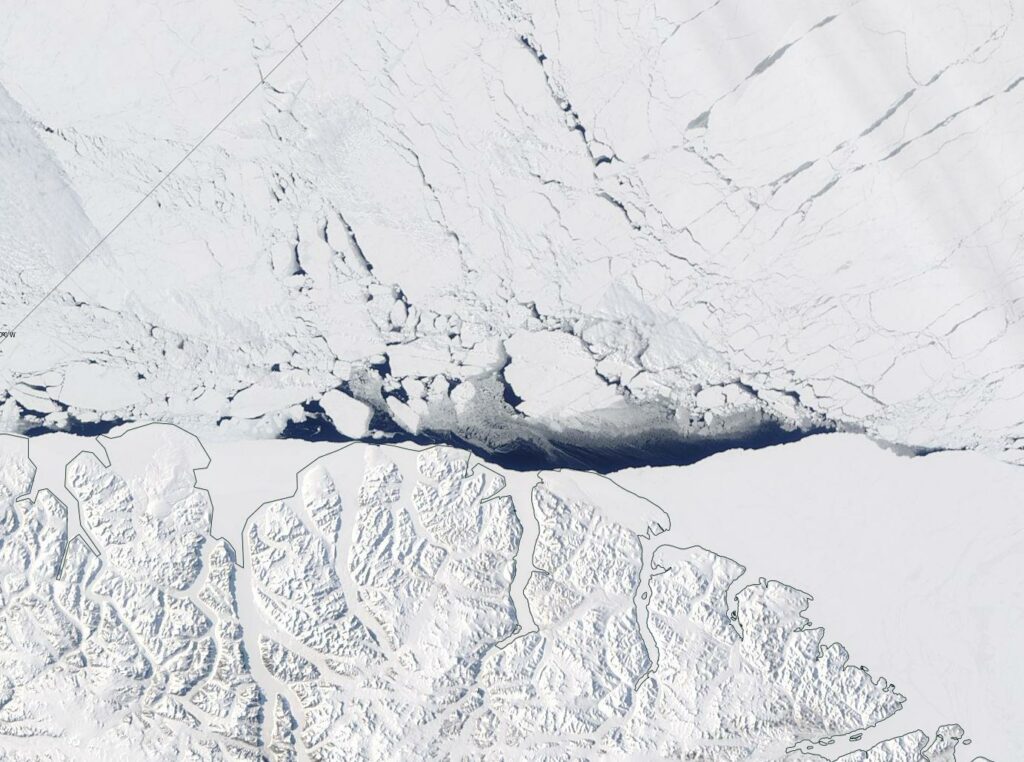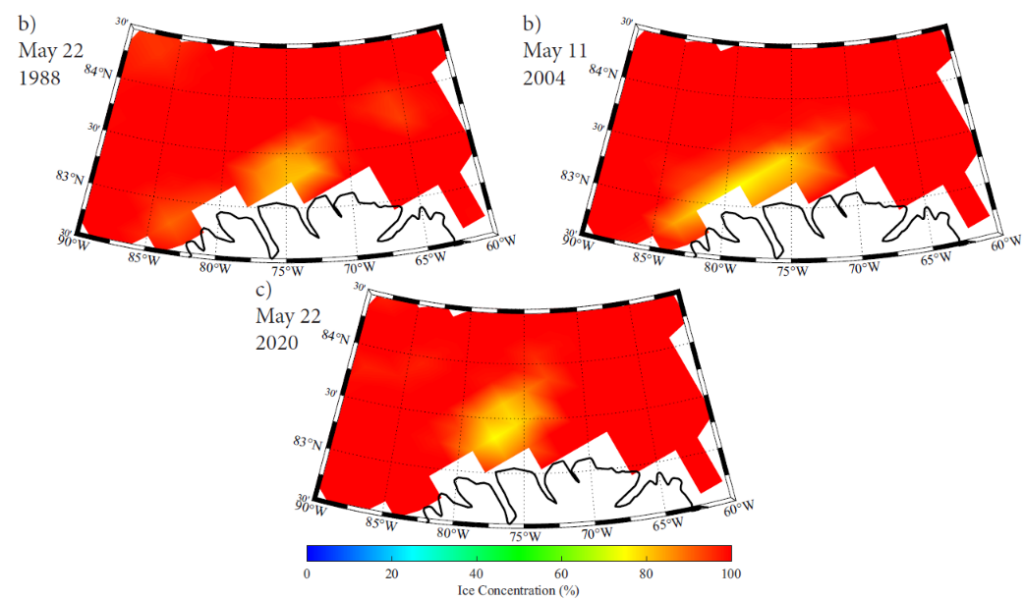A recent paper by Kent Moore et al. has caused something of a stir in the mainstream media recently, as well as in cryospheric circles and amongst the cryodenialista:
“First Observations of a Transient Polynya in the Last Ice Area North of Ellesmere Island“
The area to the north of Ellesmere Island and Greenland contains the Arctic’s thickest ice and it is predicted to be the last to lose its perennial ice, thus providing an important refuge for ice-dependent species. There is however evidence that this Last Ice Area is, like the entire Arctic, undergoing rapid changes that may reduce its suitability as a refuge. During May 2020, a polynya developed to the north of Ellesmere Island in a region where there are no reports of a previous development. We use a variety of remotely sensed data as well as an atmospheric reanalysis to document the evolution and the dynamics responsible for the polynya. In particular, we argue that anomalously strong divergent winds associated with an intense and long-lived Arctic anti-cyclone contributed to the development of the polynya as well as similar previously unreported events in May 1988 and 2004.
Curiously the paper neglects to mention a polynya in the same region that we reported on, albeit in passing, in August 2018. Here’s an updated video of that event, with the addition at the start of a yellow arrow to highlight the part of the Arctic’s “Last Ice Area” investigated by Moore et al. and a pale blue arrow to highlight Kap Morris Jesup, the most northerly point in Greenland:
Next here’s another animation, covering the time period discussed in the paper and continuing throughout the summer of 2020:
Comparing the two animations it is obvious that the August 2018 polynya is much larger than the one in May 2020, confirmed by a quick area computation using NASA WorldView:

The introduction to the paper states that:
Flaw leads, elongated regions of open water that develop along the interface between land fast and pack ice (Barber & Massom, 2007) are common in the region. Indeed Peary’s 1909 sledding expedition to the North Pole was delayed as a result of a large flaw lead that developed north of Ellesmere Island (Peary, 1910). However, the development of a polynya in this region has not been reported previously.
To my eye the image above reveals something far too wide to be described as a “flaw lead”, but let’s delve deeper into the paper:
A perspective on the unique nature of the May 2020 event is provided by the monthly mean area of open water in the area of interest during May for the entire period of the ASI data set, 2003–2021 (Figure 2h). Typically the area of open water during May in the region is less than 160 km2. May 2020 is the only year in which the area of open water exceeds 2 standard deviations above the mean.

Perhaps the polynya in question is indeed “unique in the month of May”, in which case it would no doubt have been helpful if the abstract and/or the introduction to the paper had mentioned this subtlety. Then the plethora of erroneous statements in the media like the one recently referenced by Mark Lynas on Twitter might have been avoided?
The polynya is the first one that has been identified in this part of the Last Ice Area, according to a new study detailing the findings in the AGU journal Geophysical Research Letters.
Since Mark, amongst others, seem to be suffering from the misapprehension that “The Arctic’s ‘Last Ice Area’ is cracking, just in time for COP26” here is what’s been happening in the “Last Ice Area” this year, in the run up to next month’s conference in Glasgow:
Finally, for the moment at least, are MODIS images of the May 20th 2020 polynya:

and the one on May 12th 2004:

Neither Aqua or Terra had been launched in 1988 of course, and Landsat 5 didn’t cover the north of Ellesmere Island. This is the SSM/I & SSMIS visualisation of all three May polynyas from the supplement to Moore’s paper:

It seems as though even the American Geophysical Union is not immune from tweeting erroneous information about “The Last Ice Area”. Hence:
https://twitter.com/GreatWhiteCon/status/1451142460760018945
Whether it’s the mythical “last ice area” or the more social pressure to say that the Arctic warms “twice” (and not 3, 4, 5 times) as fast as the globe on average, there seems to be a non-Zero element of fakery to so-called ‘Climate Science’. Or put slightly differently, ‘Climate Science’ doesn’t seem to be a science at all. At least not a very scientific kind of science. Just notice how whether or not we already tipped any Tipping Points at all seems to be all down to the individual feelings of any particular day of any of the actors in the field. And very frustratingly so. If it were a science, there’d be “ways of telling” (Monty Python pun) whether a Tipping Point was tipped. But the IPCC didn’t acknowledge a single one. And most new science reports don’t seem to either. So it’s all down to the individual and how he/she/it feels from day to day now, innit. There’s no science and no scientific method for settling the issue, which just happens to be the most crucial issue in, say, a 100,000 years. So clearly climate ‘science’ is not a real science.
I’ve just been endeavouring to explain to a “skeptical” fellow on Twitter that (s)he’s overly cynical. It seems as though I may have to suggest the same to you?!
I have met Tim Lenton for example:
https://skepticalscience.com/transformational-climate-science-exeter-university.html
He does get a mention in Chapter 1 of the AR6 WG1 report:
Well, we certainly agree about this! And about most things. The finer, and more crucial, details is the tense (past/future) of the verb passed or may some day pass the Tipping Point(s). Here there’s a near total blackout from the IPCC and most profiled climate “scientists”.
They just won’t go there.
If you compare this crucial point to all the chatter about an ice-free Arctic (from 1 day to 1 month, depending on who speaks), which isn’t and won’t be a Tipping Point, it’s more or less chemical free of such predictions or estimates. But let’s assume the Tipping Points haven’t happened yet, as they claim between the lines and their silence on the matter: Wouldn’t time then be ripe for calculations and all kinds of estimate-mongering? And there’s none. Leading many people to suspect that we’re already passed that, and no one wants to spoil the good mood by bringing this up in polite company.
I don’t think I’m quite with you FE. Maybe our lords and masters are by and large failing to mention such things? However Tim Lenton is certainly still banging that drum. Here’s one recent example out of many:
“Deep learning for early warning signals of tipping points“
You know I’m mostly with you, Jim, I always were. But here you seem to have a case of Cognitive Dissonance, meaning how ever clear I put it, you still won’t get it because it contradicts some of your core beliefs. Case in point: We don’t need Tim’s Early Warning Signals IMO for this, we need a crash course in how to detect already crashed Tipping Points. Meaning how to pin-point what already happened Decades ago. Do I agree with you that it would be SWEET if we were still looking at Tipping Points at some bad thing that might happen in the future if we collectively did not act in adequate ways? Oh yeah! Is that still the situation? Sadly no.
Which “tipping point” do you think has already passed the point of no return? Preferably an Arctic related one!
It’s certainly worth applying the precautionary principle:
We shouldn’t be going anywhere near that precipice, yet we’re racing towards it. However where is the hard evidence that Planet A is already over it?
The time for this toon has come around again?
“If they can’t have science, please God, give them common sense.”
I fear that the requisite “common sense” is sadly lacking in some echo chambers one might mention?